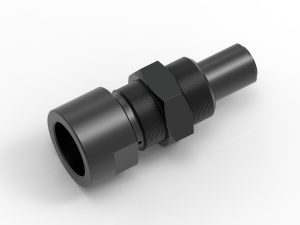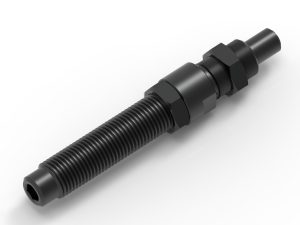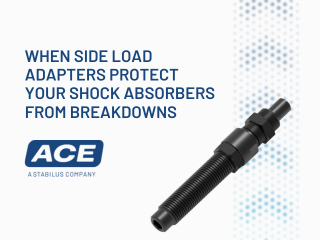Operating a motion control system in a dynamic or unpredictable environment comes with a lot of unknown factors. Your shock absorbers are placed to absorb precise forces, but they can be put under undue stress when dealing with unexpected impacts. Those unaligned forces can rapidly wear them down and even cause premature failure. That’s why side load adapters are such an integral part of ACE Control’s arsenal. Proper use of side load adapters is essential for maintaining the safety and efficiency of a motion control system, but it’s important to understand when and how they should be applied.
The most important consideration for using a side load adapter is the direction of the forces to the shock absorber. Shock absorbers that only deal with precisely aligned forces don’t have any issues that require an adapter, but how unaligned does a force have to be in order to require one? When dealing with forces that are not inline with the axis of the rod (max 3° from centerline), the forces create side load and may damage the bearing and piston rod surface, shock absorbers need an adapter to avoid damage. ACE Control’s side load adapter consists of a cap with a curved contacting surface and a pin that is guided by a long bushing, which supports the load instead of the shock absorber’s piston rod, which redistributes the lateral forces. This ensures that the shock absorber can function correctly, even under challenging conditions. By using side load adapters in applications with slight misalignments, you can significantly extend the lifespan of your shock absorbers and maintain the reliability of your equipment.


Properly functioning shock absorbers are essential for maintaining the efficiency and safety of your motion control systems, but unaligned forces can create a lot of problems that are easily missed. One clear sign that your shock absorbers are being damaged by unaligned forces is the presence of uneven marks on the piston rod, with one side being more worn down than the other. This indicates that the absorber is not handling forces as intended, which can lead to a significantly reduced lifespan, especially in applications involving rotational impacts. In more fortunate situations, this can merely lead to the breakdown of the shock absorber itself. In less fortunate scenarios, the shock aborber’s failure can potentially shut down entire production lines and cause extensive damage to machinery. This would not only result in expensive repairs but also significant downtime. By recognizing these signs early and implementing side load adapters, you can protect your equipment, extend the life of your shock absorbers, and ensure continuous and reliable operation.
While not universal, side load adapters are used in a wide range of manufacturing, production lines, automation, and logistics industries. These adapters are particularly vital in sectors where equipment must endure repeated lateral forces or where precision alignment isn’t always feasible. In automated assembly lines where robotic arms and conveyor systems are constantly in motion, slight misalignments can occur due to wear and tear, vibrations, or varying load distributions. Logistics operations are in a similar situation, for example around transfer points, where the unpredictable nature of dynamic environments can lead to misaligned forces impacting the shock absorbers. By incorporating side load adapters into these systems, companies can mitigate the risk of equipment failure, minimize maintenance costs, and keep their operations running smoothly.
Installing a side load adapter can be the difference between whether your shock absorber will live out its entire lifespan or break down much earlier than expected. By ensuring proper alignment and redistributing lateral forces, these adapters not only extend the lifespan of your equipment but also help prevent costly downtimes and repairs. If your shock absorbers deal with forces from unaligned directions, get in touch with our applications engineers today and find out if side load adapters are the best option for you.


